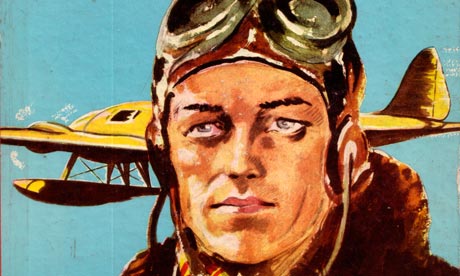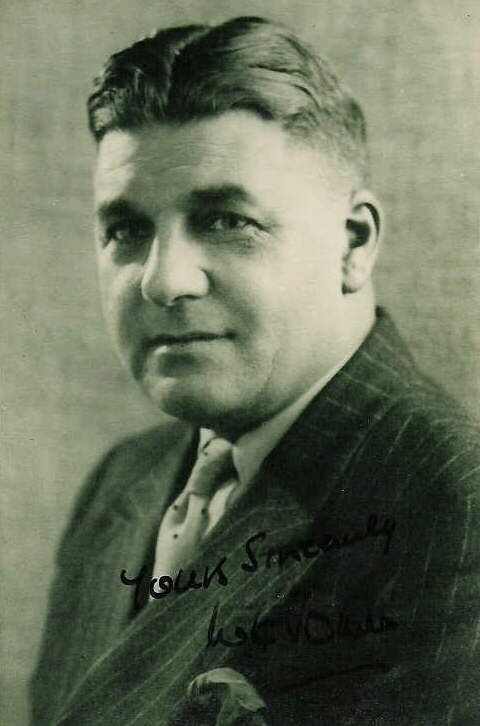Biggles learns to fly by Captain W.E. Johns (First published by Boy’s Friend Library in
1935 – original price 4d; this edition Red Fox, 2003)
16
chapters; 204 pages (but in a small format paperback)
Subjects:
World War One, France, airmen, junior fiction (Year 5-8)

(Cover of the first 1935 edition)
The Biggles books
What did I know about
Biggles or W.E. Johns before I read this book? Nothing! I had a vague
impression that Biggles was spoken of in the same tone that people reserved for Enid Blyton or
the Famous Five: fast food for the childhood mind, not to be encouraged.
But now I can see why
young readers – especially boy readers – must have devoured these in the
decades they were written, between 1932 and 1968. They are full of action, thrills
and excitement, as well as detailed and knowledgeable descriptions of flying. It was not until the 1960s onwards that they
fell out of favour, as attitudes changed and they were viewed as being racist,
sexist and coloured by outdated colonial values.
Things I didn’t know about Biggles:
- That Biggles is a nickname, short for James Bigglesworth.
- That “Camels” are a type of aircraft.(Which suggests that The Camels are coming might be about planes, not animals.)
- That Biggles first appeared in the magazine Popular Flying, which Johns had been asked to edit (April 1932), in a story credited to William Earle. A few months later, the publisher put together a collection of Biggles stories as The Camels are coming and this was the first Biggles title.
Things I didn’t know about W.E. Johns:
- That W.E. is short for William Earl.
- That he signed up with the Norfolk Yeomanry and fought at Gallipoli alongside the Anzacs.
- That he was shot down in September 1918, his observer and rear gunner was killed and he was captured and sentenced to death by firing squad, but sent to prison instead. He arrived back home on Christmas Day 1918, when his family still thought he was missing, presumed dead.
- That his rank was actually Flying Officer Johns, not Captain Johns.
- That he was also an artist, specialising in aviation art.
Things I didn’t know about airmen in the First World
War:
- That there was no air service in the early years of the First World War. According to the Author’s note at the beginning, “Fighting planes were flown by officers seconded from the Army (the R.F.C.) and the Navy (Royal Naval Air Service).” These merged in April 1918 to become the Royal Air Force.
- That at one stage, life expectancy for WW1 pilots was 11 days.
In fact, it is fascinating to read a book from the point of view of the
airmen, when most books concentrate on life in the trenches. Here, the men on
the ground are only viewed from above, or occasionally met in person when
Biggles has to do a crash landing and get back across the Lines.
According to this newspaper article, there was a real James Bigglesworth. ("A combat report by 2nd Lt James Bigglesworth was recently discovered in a collection of W E Johns’ manuscripts and typescripts that had been in the Museum’s possession since the early 1980s but are only just being catalogued. The folded combat report had been tucked into the manuscript of “Biggles back of beyond” (published in 1953 as “Biggles in the Gobi”) perhaps to mark a page to which Johns wished to return.") However, the newspaper had been taken in - on the following day the RAF Museum admitted it had been as April Fools joke, albeit with a serious purpose.
Synopsis:
The Author’s note explains that this book was written “as the answer to those who have asked
when and where Biggles learnt to fly.” That means it’s one of the first
Biggles books in terms of chronology, but not the first one to be written (which, as noted above, was The Camels are coming in September 1932.)
Biggles is sent to
France in 1916, aged 17, with less than 15 hours flying experience, and no
experience at all in combat flying. This was something the pilots picked up as
they went along, and reading the descriptions of battles in the air, it’s surprising that any of them managed to survive. His observer for most
of the book is Mark Way, “a deeply tanned, keen-eyed young officer” who “came
over with the New Zealand contingent; my home is out there.” (“Sporting of you
to come all this way to help us,” Biggles says.)
This page, written by a Biggles enthusiast and collector, points out that the book was originally a set of short stories, which explains why
some of the breaks between chapters seem a bit abrupt.
Reviews:
This is an interesting overview of changing attitudes to the Biggles books.
And another piece from the Guardian describes this author’s boyhood
obsession with his hero, Captain James Bigglesworth. “You knew where you stood with Biggles.
There was good and there was evil and nothing in between... I longed to fly with Biggles.”

Questions:
How are
these books different from war books written for young people today?
One difference
I noticed is the reliance on speech tags and adverbs which make the author’s
style so easy to parody. For example,
“Pretty good!” he muttered admiringly.
“I think I am,” replied Biggles frankly.
“Maybe they won’t be quite as chirpy in
future!” observed Biggles modestly.
The slang
sounds old-fashioned to our ears – beastly,
jolly sporting – and it’s also easy from this distance to criticise
sentences like these:
Biggles was warmly congratulated on his rescue
work, which everyone present regarded as an exceptionally good show.
Descriptions
of battles often show little compassion for the enemy, who are characterised as
Huns, sometimes even as “that skunk,”, “the unspeakable hog!” or “you cunning
hound.”
About the author:
“Captain
W.E. Johns was born in Hertfordshire in 1893. He flew with the Royal Flying
Corps in the First World War and made a daring escape from a German prison camp
in 1918. Between the wars he edited Flying
and Popular flying and became a
writer for the Ministry of Defence....W.E. Johns went on to write a staggering 102 Biggles
titles before his death in 1968.”
Of course
there is a Biggles fan-based website, in fact two - one for the author and one for the books.

Other books you might like:
Code Name Verity and Rose under fire are set in WW2 but also include descriptions of learning to fly, and of flying
over enemy territory.
The Flambards
trilogy by K.M. Peyton is set in England before and during the First World War.
One of the sons, William, wants to
become an aviator.
New Zealand connections:
Captain K L Caldwell, DFC,
MC, Croix de Guerre of Auckland became New Zealand's highest-scoring pilot with
25 victories. These are some articles and letters by and about him.
The website of the NZ Embassy in France also has a page on New Zealanders in the air war, 1914-18.
"Captain Clive Franklyn Collett MC and
Bar, became New Zealand's first fighter "ace" with 11 victories. Born
in Blenheim, he studied engineering and while in Britain, joined the RFC. In
July 1917 he was posted to 70 Squadron on Sopwith Camels where he acquired a
fearless reputation. His operational flying over, he was testing a
captured German Albatros fighter over the Firth of Forth on 23 December 1917
when he flew into the sea losing his life."



